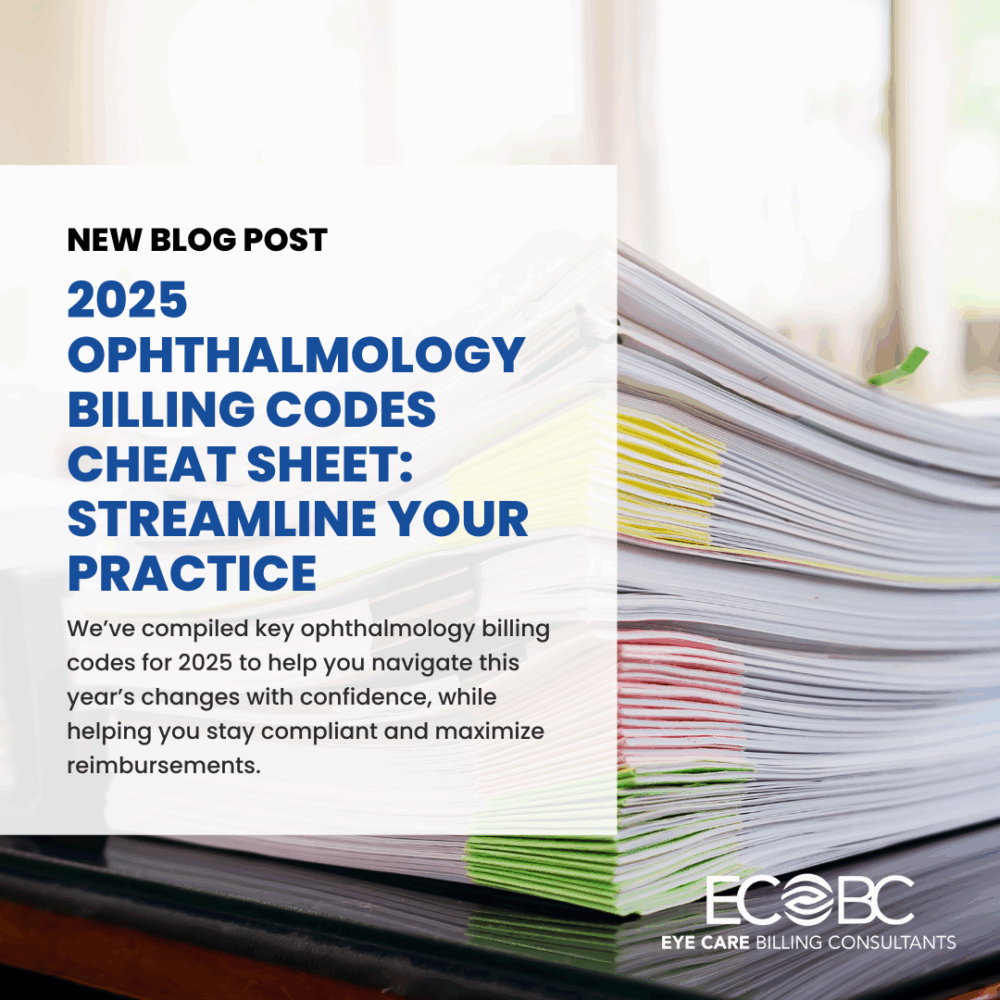Add Your Heading Text Here
Accurate billing is the backbone of any successful ophthalmology practice. With annual updates to CPT®, ICD-10, and HCPCS codes, staying current is critical to avoiding claim denials and ensuring timely payments. Below, we’ve compiled key ophthalmology billing codes for 2025 to help you navigate this year’s changes with confidence, while helping you stay compliant and maximize reimbursements.
Evaluation & Management (E/M) Codes
E/M codes remain foundational for office visits and consultations. Key updates for 2025 include revised documentation guidelines for prolonged services:
- 92002 – Ophthalmological E/M, new patient (intermediate)
- 92004 – Ophthalmological E/M, new patient (comprehensive)
- 92012 – Ophthalmological E/M, established patient (intermediate)
- 92014 – Ophthalmological E/M, established patient (comprehensive)
- 99213 – Office visit, established patient (15-24 minutes)
Tip: Verify the level of medical decision-making (MDM) or time-based coding rules for E/M visits to ensure proper code selection.
Diagnostic Imaging & Testing
Ophthalmic imaging and diagnostic tests require precise coding. Newer codes for 2025 emphasize optical coherence tomography (OCT) and visual field testing:
- 92133 – Scanning computerized ophthalmic diagnostic imaging (e.g., OCT), posterior segment
- 92083 – Visual field examination, extended (e.g., Goldmann perimetry)
- 92250 – Fundus photography with interpretation
- 76511 – Ocular ultrasound, diagnostic (A-scan)
Important: Always pair imaging codes with a relevant ICD-10 diagnosis (e.g., H35.00 for diabetic retinopathy).
Surgical Procedures
Common ophthalmology surgeries, including cataracts and glaucoma interventions, have specific coding requirements:
- 66984 – Cataract surgery with IOL placement (one-stage)
- 66174 – Trabeculostomy ab interno (e.g., minimally invasive glaucoma surgery)
- 67028 – Intravitreal injection (e.g., anti-VEGF therapy)
- 65855 – Laser trabeculoplasty
Modifiers to Remember:
- -LT (Left eye), -RT (Right eye), -50 (Bilateral)
- -XE (Separate encounter) for injections administered on a different date.
New & Revised Codes for 2025
The AMA introduced several updates to reflect advancing technologies and procedures:
- XXXXX – [Hypothetical placeholder for new codes – consult CMS.gov or AMA for 2025-specific additions]
- XXXXX – [Example: New code for AI-assisted retinal imaging analysis]
Watch For: CMS may adjust reimbursement rates for high-volume codes like intravitreal injections (67028). Check the Medicare Physician Fee Schedule for updates.
Common ICD-10 Codes
Link procedures to diagnoses to avoid denials:
- 111X – Primary open-angle glaucoma, right eye
- 9 – Unspecified age-related cataract
- 32 – Dry age-related macular degeneration
- 9 – Unspecified keratitis
Tips to Avoid Billing Errors
- Document Laterality: Always specify left, right, or bilateral involvement in notes and coding.
- Bundling Alerts: Confirm code bundling rules (e.g., postoperative care included in surgical codes).
- Stay Updated: Subscribe to CMS newsletters or use AAPC resources for real-time code changes.
How Eye Care Billing Consultants Can Help
Navigating ophthalmology billing codes can be overwhelming, especially with annual updates and payer-specific rules. Eye Care Billing Consultants specialize in streamlining this process for practices. They conduct audits to identify coding errors, train staff on documentation best practices, and ensure compliance with 2025 guidelines.


